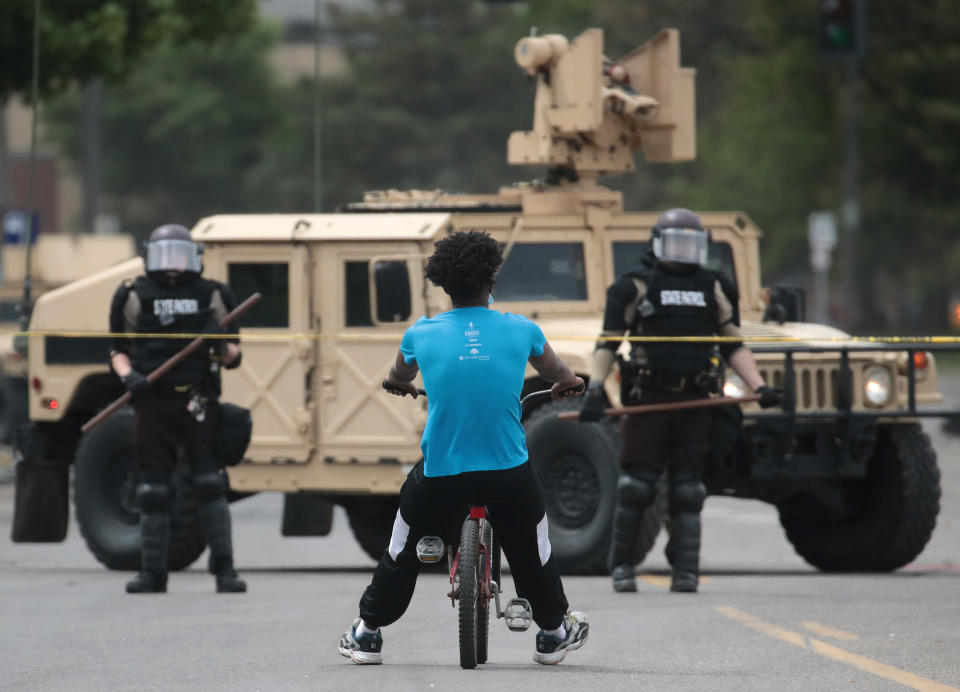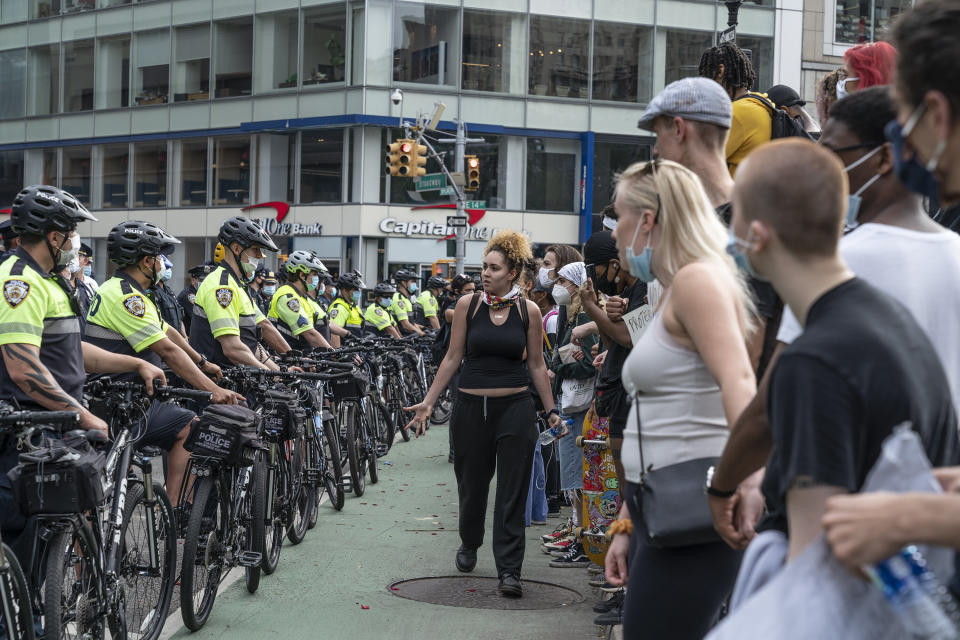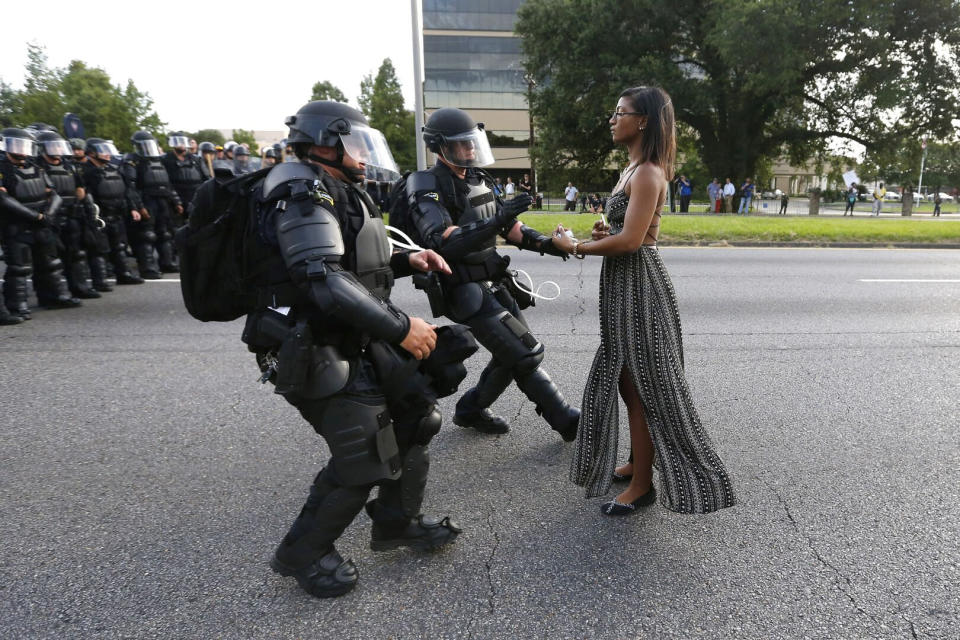Why Protesters In Minneapolis Are Facing Militarized Law Enforcement

Long before this week’s clashes between police and demonstrators protesting police brutality, the Minnesota State Patrol made a request that foreshadowed the shape of the chaos.
In a letter to a Pentagon program that repurposes weapons and armored vehicles from foreign wars for domestic police forces, the agency said its SWAT team could use a mine-resistant vehicle for what it referred to not as police work but as “deployments.”
“The team does not have a vehicle capable of providing any level of ballistic protection which greatly increases the risks during deployments,” the agency wrote. Asking for a “Stryker, Cougar, Caiman, MaxxPro, MRAP, or any similar vehicle” — all vehicles designed to withstand explosions from landmines or improvised bombs — the agency said its SWAT team could use such a vehicle for “high-risk warrants, hostage rescue, barricaded suspects, counter-drug activities, counter terrorist incidents, VIP motorcades, and dedicated response to incidents at two nuclear power plants,” and the protection of the state Capitol.
The 2012 request was part of a trend that nearly always becomes obvious when officers respond to large-scale protests of police violence. Across the country, many law enforcement agencies have grown indistinguishable in their tactics or equipment from the military thanks to federal government programs that have flooded local police departments with military equipment. As a result, critics say, police are more likely to use disproportionate force against ordinary people, and their response to protesters can become dangerous.
The Minnesota State Patrol is one of several agencies responding to the Minneapolis protests over the police killing of a Black man. And like law enforcement agencies before them — in Ferguson, Missouri, and Baton Rouge, Louisiana — some of the officers are outfitted for a battle.
“We always do this,” Minneapolis City Council member Jeremiah Ellison said to MPR on Wednesday. “We create a barrier, put the police out there, put them in a line, put face masks, depersonalize them, make them look as scary as possible, and we always get this result, and then we want to point the finger at community members.”
One night earlier, hundreds of citizens had gathered in Minneapolis near the spot where 46-year-old George Floyd died in police custody. Floyd, a Black man, died shortly after a white officer, Derek Chauvin, knelt on his neck while Floyd complained he couldn’t breathe. Bystanders captured the act on video. The city fired Chauvin earlier this week but did not arrest him until Friday. He’s been charged with third-degree murder and second-degree manslaughter.
Minneapolis police officers wore body armor and carried riot gear to face off with visibly unarmed protesters who were wearing T-shirts and carrying signs. After some in the crowd began to break windows and spray graffiti, officers fired tear gas and foam pellets. Nearby buildings and businesses were set on fire during the protests.
Video from a second protest on Thursday evening appeared to show police arbitrarily spraying mace from an SUV as it drove by protesters. Early Friday morning, Minnesota State Patrol officers in body armor and riot gear swarmed the area around a burning police precinct and arrested members of a CNN camera crew without any obvious cause. By Friday midday, officers of the Minnesota State Patrol were manning one checkpoint with the kind of heavily armored vehicle the agency once requested from the Pentagon, although the vehicle likely belonged to the Minnesota National Guard.
Under the headline “Why Does the Minneapolis Police Department Look Like a Military Unit?” civil rights activist and writer Philip V. McHarris directly linked the officers’ posture to the way they use deadly force against ordinary people.
“Tough-on-crime policies and militarized police departments have paved the way for increased police contact and tragic violence,” he wrote in The Washington Post. “Reducing the capacity for police to engage in routine and militaristic violence is the only way to break recurring cycles of police killings and the militarized response that protests of them are often met with.”

It’s true that the way police came prepared for these protests is part of a pattern. Six years ago, demonstrations in Ferguson, Missouri, over the police killing of Michael Brown ignited widespread criticism over the militarization of police. Over several days of protests, officers wearing camouflage stood on top of mine-resistant vehicles and aimed military-style firearms at unarmed protesters. The Senate held hearings on the militarization of police, where then-Sen. Claire McCaskill (D-Mo.) fumed that “lawful, peaceful protesters did not deserve to be treated like enemy combatants.”
Two years later, police in Baton Rouge came outfitted in riot gear to largely peaceful protests of Alton Sterling’s death in police custody.
Hundreds of local law enforcement agencies across the country have access to the same kinds of military vehicles, tactical gear and firearms. For decades, the federal government has made it possible for local police to obtain military gear to use in the “war on drugs.” The wars in Iraq and Afghanistan turbocharged the flow of military gear to small-town police forces as the Pentagon sought new homes for the tons of equipment coming off the battlefield. Countless departments also spent their own funds to acquire militaristic equipment from private companies.
In the wake of the Ferguson protests, the Obama administration placed restrictions on the most notorious of the federal programs, which had distributed mine-resistant vehicles, bayonets and tanks to small-town police departments. But a Government Accountability Office investigation found that the restrictions were essentially a fiction; investigators set up a fake police department and, with minimal vetting, were able to obtain a pipe bomb.
As more police agencies militarize, there is evidence that it warps police work itself. Some research has found that police officers are more fatally violent in precincts that obtain military gear. An ACLU analysis around the time of the Ferguson protests found that agencies were routinely using armored vehicles and flash-bang grenades to perform low-stakes tasks such as serving arrest warrants.

“The militarization of American policing is evident in the training that police officers receive, which encourages them to adopt a ‘warrior’ mentality and think of the people they are supposed to serve as enemies, as well as in the equipment they use, such as battering rams, flashbang grenades, and APCs,” the report read.
In 2015, I obtained the requests that hundreds of police and sheriff departments had made to the Pentagon program, known as the 1033 program, that redistributed mine-resistant vehicles. Dozens of departments said they could use an armored vehicle for low-stakes drug enforcement operations or to police events like college football games and busy beach days. When I spoke to some of these agencies, many said they liked the vehicles simply because they were free.
Among those requests was the Minnesota State Patrol’s for an armored vehicle. It’s not clear if the Pentagon ever honored its request or if the agency obtained military-style gear another way. A spokesperson for the state patrol did not respond to HuffPost’s questions.
In addition to claiming it could use an armored vehicle in terrorist attacks and active shooter situations, the Minnesota State Patrol noted in its request that it was the primary agency charged with “the protection of the State Capitol Complex.” The state Capitol also happens to have been the site of a recent protest — in April, when hundreds of mostly white protesters, including a few who appeared heavily armed, gathered there and outside of Gov. Tim Walz’s residence to protest public health shutdowns over the coronavirus pandemic.
There were no riot police in sight.
Love HuffPost? Become a founding member of HuffPost Plus today.
This article originally appeared on HuffPost.
